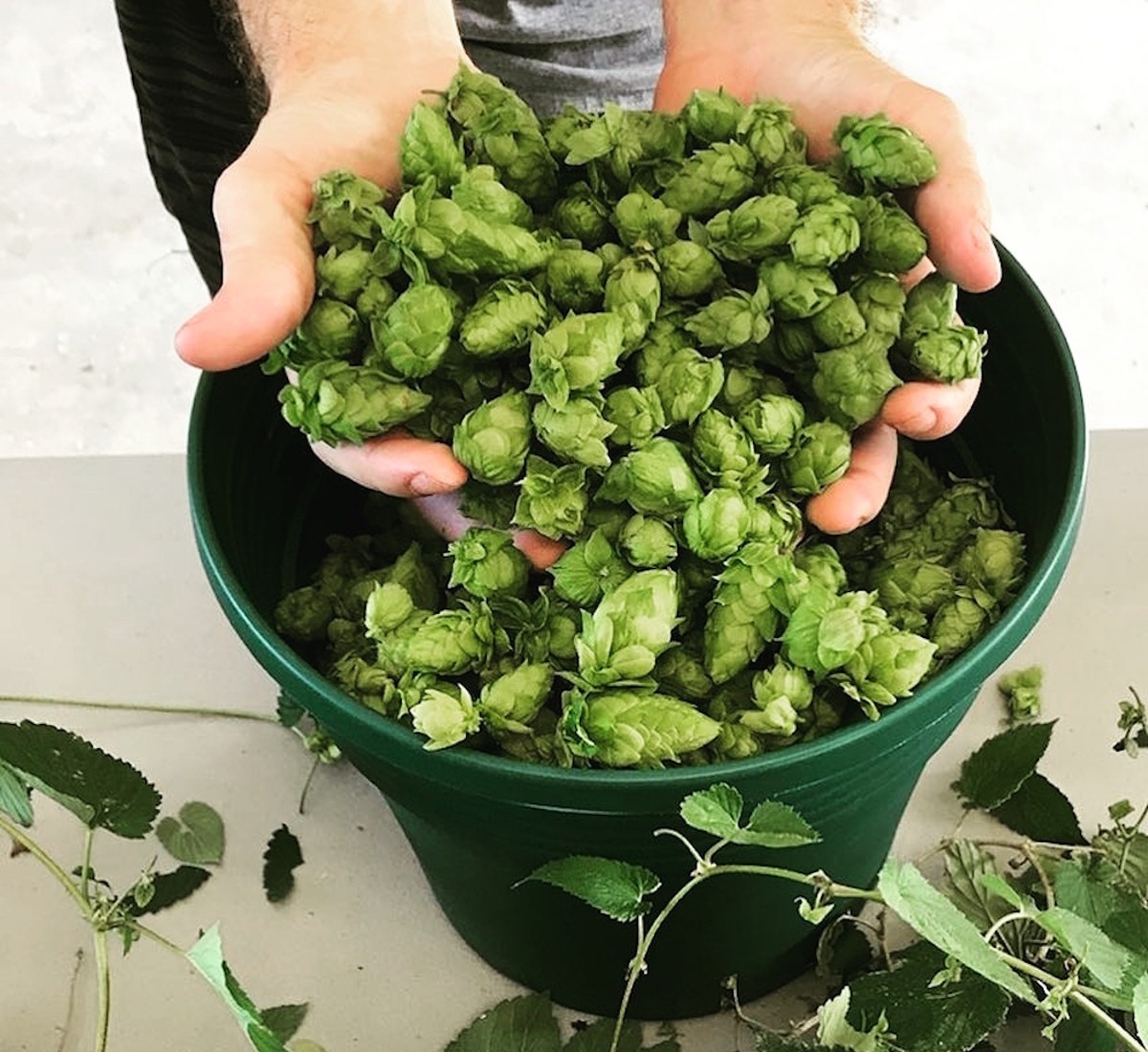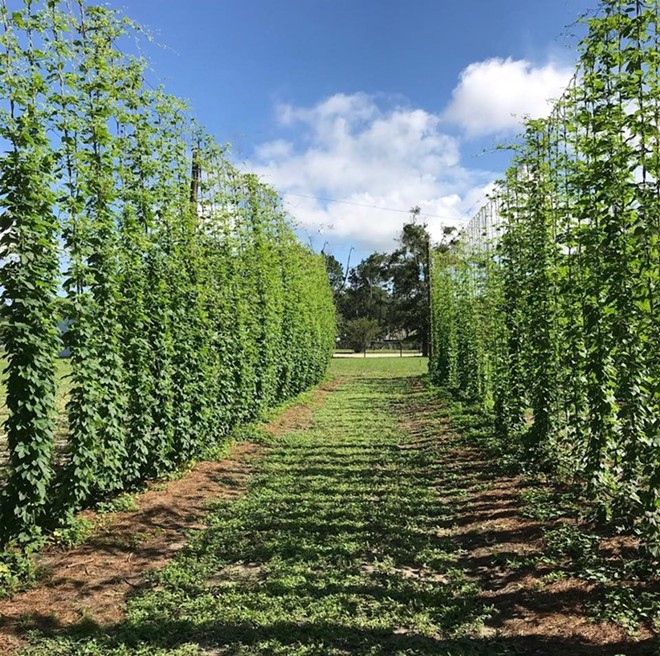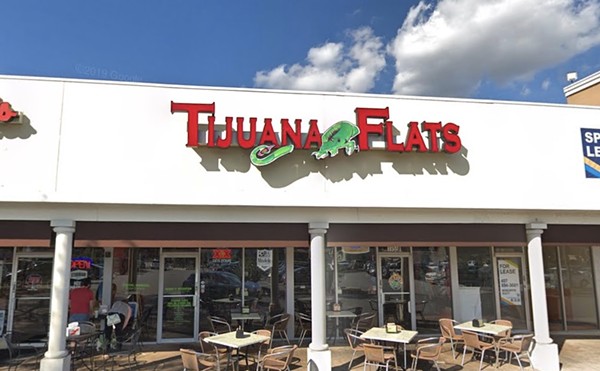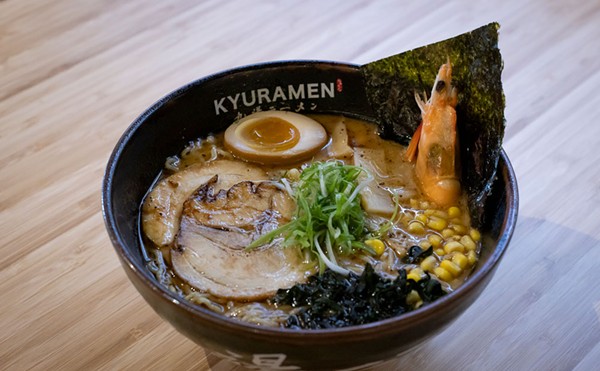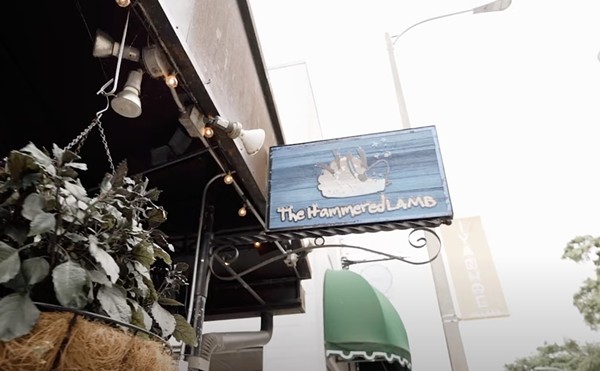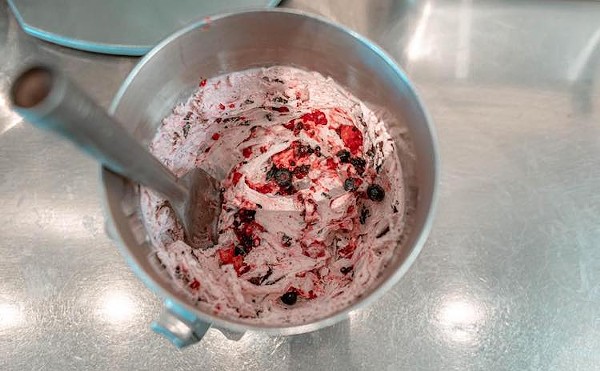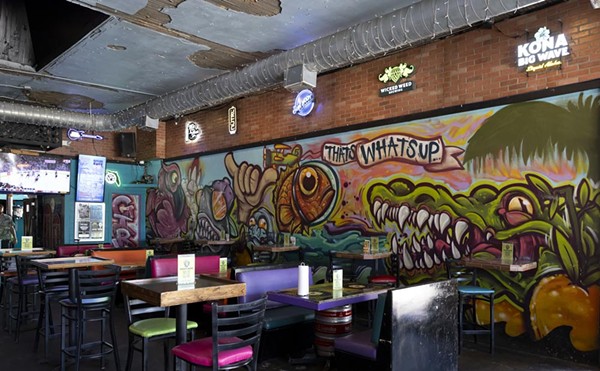Quick, imagine the aroma and taste of a beer made with ingredients grown only in Florida.
If your first thoughts are sunscreen, swamp water or eau de T-shirt shop, we'll forgive you. Seriously, though, the local craft brew industry is experimenting with local ingredients, and the outlook is promising.
A Zellwood nursery is growing a regular crop of hops now, and Charles Barrett, a University of Florida researcher, recently grew a batch of barley at a UF farm east of Tallahassee. Using those ingredients, Hourglass Brewing in Longwood produced a 5-gallon batch of an unnamed but very Florida beer for the recent Florida Brewers Conference in September, held in the Renaissance Orlando at SeaWorld. It is believed to be the first beer ever brewed with the major ingredients – barley and hops – grown in Florida.
"We were worried it would be too low in alcohol, but it wound up being almost 9 percent," says Matthew Gemmell, one of two head brewers at Hourglass. "And the flavors wound up really nice." He says he was thinking along the lines of orange groves, cypress, sea breezes and crystalline spring water for inspiration, which truly are abundant Florida resources.
Also at the tasting event was Greg Piecora, owner of Wops Hops Brewing in Sanford. He says he liked the unnamed "very Florida beer."
"If you put ingredients in the hands of a good brewer, you can get the flavor you want," Piecora says. "It wasn't necessarily a Florida flavor, but it was the right flavor for those particular Florida ingredients."
Either way, Florida's craft brewing industry is well on its way to developing a truly locavore sudsy mug. The only not-from-Florida ingredient in Hourglass's native brew was the yeast, but they plan to brew another batch using airborne or native yeast – a process known as spontaneous fermentation. Gemmell and his co-head brewer, Michael Delancett, didn't have time to make that happen this year, but they are aiming to do it some time in winter of 2019. Barrett is trying to make sure there's a good grain crop for the next attempt, Gemmell says.
Besides ongoing trends supporting local food sourcing and craft brewing, the drive to grow beer ingredients in Florida is, oddly enough, a result of climate change.
Climate change has made it more possible to grow hops and barley in Florida for two reasons. First, there's a bigger risk of drought in northern agriculture centers like Washington state's Yakima Valley, which is where the vast majority of U.S. hops are grown. Second, warmer winters overall mean less risk of a freeze in Florida.
As of June 30 this year, there were 6,655 active breweries in the U.S., up from 5,562 the prior year. An estimated 2,500 to 3,000 breweries were in planning, based on active Alcohol and Tobacco Tax and Trade Bureau licenses, according to the Boulder, Colorado-based Brewers Association.
But the pace of growth has shown signs of slowing in the past couple years, particularly in overall sales volume. Nationally, sales growth slowed to 5 percent in 2017 after double-digit increases for several years, the association says. That suggests the national appetite for craft brew is closer to being satisfied.
Then there's Florida. The craft brew scene was slower to heat up here, particularly in the Orlando area. Central Florida started catching up to the national trend in the past three years. Craft brewing most recently found a home in Sanford, where you can sample craft brew at half a dozen spots within a few blocks downtown.
At the same time, climate change has prompted serious worry among hops growers and grain farmers. A Western drought in 2015 challenged hops growers. Leading breweries signed a "climate declaration" to call attention to the specific risks and opportunities of climate change on the beer industry.
"Warmer temperatures and extreme weather events are harming the production of hops," the declaration said. "Rising demand and lower yields have driven the price of hops up by more than 250 percent over the past decade. Clean water resources, another key ingredient, are also becoming scarcer in the West as a result of climate-related droughts and reduced snowpack."
Due to those concerns, as well as the desire to advertise local origins on everything from meat to beer to vegetables, hops growing has started to diversify and move into different states that hadn't seen significant hops crops for decades.
Many local farmers are not yet aware of the demand for grain and hops coming from local microbreweries, says Richard Smith, a former researcher with University of Florida who recently started his own company, Florida Hops LLC.
He's been studying which kinds of hops grow best in the state's sandy soil, sweltering summers and mild winters. Grains to make alcohol are more challenging, he says, because they generally don't do well in tropical conditions. Currently in Florida some grain is grown, but it is mostly used for animal feed.
"Farmers could make two or three times as much money growing barley for sale to local brewers, rather than animal feed, if they started growing it," Smith says. "Many of them have all the equipment they need."
The Roberts family has grown ferns and foliage in Zellwood for years. Recently Matt Roberts decided to try out some of Smith's research on a bigger scale and plant a hop crop.
In July, about 100 people showed up for a "you pick" event for the first crop.
"I want to keep it as local as possible, if we have enough breweries here in Central Florida to supply," Roberts says. "So far it's going really well. I also hear from several local homebrewers every day."
One hurdle to growing hops in Florida is the length of daylight during the summer, which is actually shorter in Florida than up north because of the angle of the earth as it tips toward the sun.
To address that issue, Roberts and Smith decided to use bright halide lighting around the perimeter of the three-quarter-acre plot dedicated to the hops vines. With a few extra hours of light, the hops produced significantly more blooms.
One of the crop's biggest problems – powdery mildew – hasn't shown up yet, he says. But he did have a problem with spider mites. "We used a mostly organic pesticide, neem oil, to disrupt the mites," he says.
The farm now has 600 hops plants, about half of which are the common Cascade variety. The other half is a mix of 11 varieties, and two of them didn't perform well.
Previous attempts to grow hops in Florida yielded only about a quarter of a pound per plant. Roberts got about a pound per plant and was happy. Up north they get six to seven pounds per plant.
"We have no idea how long we're going to be able to use the same plant yet. If we get two crops per year, that will help a lot with the money equation, and in terms of competing with the northern growers," he says.
"Regionally, I think there is a chance to help fill in from the national scare on climate change and drought," Roberts says.
Ultimately the biggest selling point for local hops and barley, hopefully, will be taste.
"The consumer would have a different experience with these hops than with hops grown in Yakima, for example, especially if they are used when fresh, which we call a wet hop brew," Smith says.
"Local hops, like grapes, are known for regional quality difference," he adds. It's a concept known in wine and brewing as terroir, a French word to describe all the environmental factors that affect a crop's flavor and character. Smith plans to be at the 2018 Orlando Beer Festival with a keg of beer brewed with Florida hops, as well as seedling hops plants from Roberts' farm.

